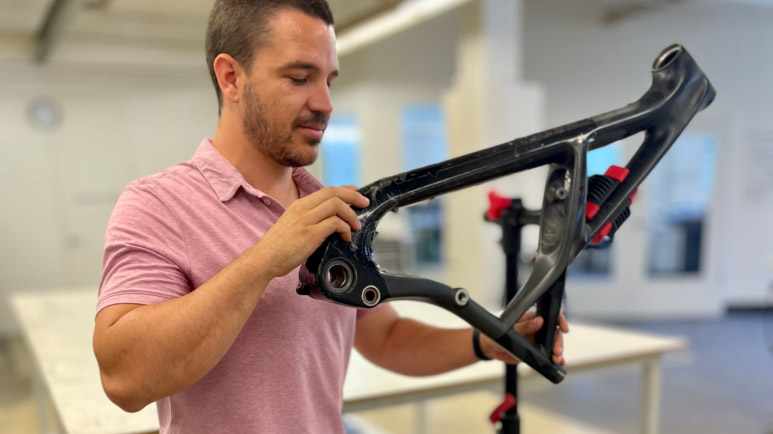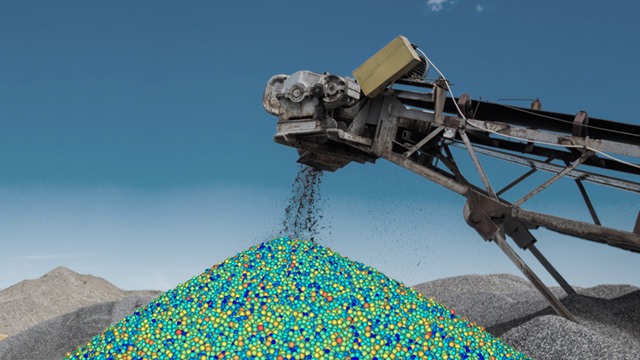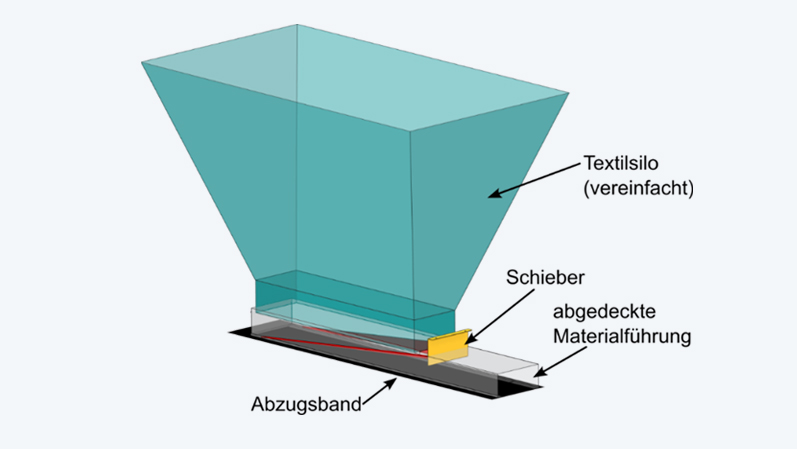Electromagnetic heating of a spinach pizza
Dr.-Ing. Jörg Neumeyer
01.04.2025
Tech Article 25/02 | Culinary heat treatment supported by simulation
In the 19th century, it was discovered that spinach has an exceptionally high iron content. Today, iron is a widely used material in industry and an integral part of e-machine construction. Simulation shows how the findings on the electromagnetic effects of iron can be used profitably in the preparation of spinach-based dishes.

© Getty Images / Adobe Firefly / CADFEM Germany GmbH
Direct or indirect method …
… that could be the question here. The processes in electrical heat treatment technology are basically divided into direct and indirect processes. Which variant is more suitable for the heating process under consideration depends on the geometry and material of the device to be heated, the need for embedding in automated processes, the efficiency and costs of energy provision and many other boundary conditions. The two terms can be easily explained and differentiated using the example of the domestic baking oven, which is already of great importance with regard to the main application of this article.
“Direct” processes are characterized by the fact that they generate the losses required for heating inside the body to be heated. In the kitchen oven, this effect occurs in the heating coils through which an electric current flows. This current causes Joule losses inside. Very high power densities are generated due to the possible high currents, which quickly brings the heating coil up to working temperature. “Indirect” processes work via the three types of heat transfer (conduction, convection, radiation) and, using our example, describe the heat transfer from the hot heating coil to the pizza in the oven.
Indirect processes are slower and their maximum temperature is limited by the heat source, but they are suitable for more geometries and materials. Since a pizza has poor electrical conductivity and is difficult to contact via electrodes, it is heated indirectly. However, to ensure that the pizza is also baked on the inside, the interior must be heated from the outside via heat conduction. This extends the baking time and may result in burnt edges. In the case of a spinach pizza with a high iron content, a combination of classic indirect methods and direct methods using electromagnetic losses could solve these problems.

Direct and indirect heating in the oven | © Getty Images
Spinach garnished with electromagnetics
Eddy current and remagnetization losses are primarily suitable for generating electromagnetic losses in the spinach. Effects such as magnetostriction and thus lossy changes in length or similar are neglected here. Eddy currents require conductive areas for closed current paths, which fluctuate greatly, however, due to harvesting, cleaning and natural structural variations. Theoretically, an extremely high frequency according to δ=1/√(σ∙π∙μ∙f) could be used to generate eddy currents in small iron nests, which must be at least four times as large as δ, but this would hardly be feasible in practice - despite the high permeability of iron.
Remagnetization losses occur due to the alignment of the elementary magnets in the iron according to the external magnetic field. If the direction of the magnetic field changes, the elementary magnets also change their orientation. If this change occurs at a high frequency, relevant losses occur due to the realignment. Simulation models in which data for conductivity and remagnetization losses can be stored are suitable for quantifying these losses. The associated loss coefficients can be specified directly in Ansys Maxwell or determined automatically using so-called P-B curves.
At this point, however, we would like to point out a common problem with the availability of material data. One aspect that will be addressed later in the article, but is worth mentioning now, is the temperature dependence of B-H characteristics. This data is essential, especially for the simulation of electromagnetically excited heating processes; yet it is hardly available. The same currently applies to the P-B curves in relation to spinach. Using the data from iron or steel at least provides an upward estimate.

Determination of loss coefficients in Ansys Maxwel | © CADFEM Germany GmbH
Electromagnetics and thermals as the main ingredients
Let's postulate that the material data is correct to the extent that the electromagnetic losses are determined by the simulation in a reasonable order of magnitude. However, in order to simulate the heating within the pizza, a further step of coupling between electromagnetics and temperature field is necessary. In this context, the losses form the load or source term of the heat conduction equation. Since, in addition to the locally inhomogeneous electromagnetic heating, the classical, indirect heating must also be taken into account and material data are highly non-linear, an analytical approach is not possible.
Within the thermal simulation, material data can be defined depending on the temperature and effects such as the transformation from solid to liquid. The transformation can be taken into account via “jumps” in the specific heat capacity. For our application, this applies in particular to cheese, which counteracts the temperature increase at constant heat output due to its phase change. Classic mozzarella certainly behaves very differently from feta, which is often used for spinach pizza, but at this point we are back to the material data problem already described above. In addition to the non-linear effect within the temperature field, the data in the electromagnetic field also changes.
This leads us to a further justification of the numerical simulation approach: by feeding back the temperature to the electromagnetics, the electromagnetic material data can be adjusted. In our case, this applies to the loss coefficients, but in principle the procedure would also be possible for permeability, electrical conductivity, etc. This adaptation in turn changes the power in terms of quantity and homogeneity, which has an effect on the heat input and thus the temperature curve. In order to represent the transient heating process in the best possible way, feedback from temperature to electromagnetics should be carried out at several points in time (reference value: 5-20).

Temperature dependence of heat capacity using the example of pizza cheese | © Getty Images
Faster to the finished pizza
The evaluation of an improved process requires a reference result based on the status quo. In principle, one could consider a stone base with a corresponding boundary condition on the underside of the pizza – but for the analysis we assume a pure convection oven. Using a convection boundary condition on all outer surfaces with an ambient temperature of 180°C, a suitable convection coefficient for the heat transfer from air to pizza and the necessary material data (density, specific heat capacity and thermal conductivity), the temperature field in the pizza can be calculated in a transient analysis. These conditions also apply to electromagnetically assisted heating.
The result of the comparison will provide an insight into the baking times saved and the temperature in the spinach. While the established process of indirect heating has already shown through much practical experience that the spinach does not burn when prepared correctly, internal heating could lead to burning, which is anything but beneficial to the taste. The simulation results from the electromagnetics are transferred via a link and the “Imported Load” entry. As the two simulations are based on different FE meshes, the heat sources are interpolated automatically.
Taking into account the estimated loss coefficients, an electromagnetic harmonic analysis with a frequency of 40 kHz (range of conventional induction hobs) is carried out to calculate the losses. In the thermal simulation, these losses couple exclusively in the spinach and lead to inhomogeneous but faster heating. The entire thermal behavior can be analyzed using temperature plots of the entire pizza and temperature-time evaluations in the hotspot. The electromagnetic load can be switched on and off for comparative calculation, allowing the two variants to be quickly compared with each other.

Temperature distribution after eight minutes and in the hotspot over time | © CADFEM Germany GmbH

Training Tip
Simulation of Electromagnetic Fields with Ansys Maxwell
From magnetostatics to magnetodynamics: Learn, how to easily model and simulate magnets, coils, etc.
Spinach as an all-purpose remedy
Thanks to the additional electromagnetic heating, the global minimum temperature is reached around one minute earlier, which corresponds to a time saving of 13%. With regard to the highly competitive pizza delivery service market, competitive advantages can be generated in this way. Further potential lies in meat-based pizza toppings or in legumes as the basis for gluten-free pizza bases, which also have a high iron content. It has been shown that electromagnetics can help spinach, but can't spinach also be used in electromagnetics? After all, a well-known, muscular sailor with a pipe in his mouth has long had an appreication of the enormous power of spinach.
Thanks to its flat shape, spinach leaves could be used as a replacement for laminated field guide structures in electric machine construction, which would also significantly reduce the mass of the machines. With regard to e-mobility, less weight, in turn, leads to longer ranges. A cream spinach that is easy to shape would be particularly useful for induction heating processes, as inductors and their field guides must be geometrically adapted to the desired heating profile. The copper pipes are now often manufactured additively and the creamed spinach could flow into the gaps. A fluffy spinach souffle as a framing field shield would also be conceivable.
To summarize, I would like to mention again the electromagnetic and thermal simulation options with Ansys tools, which enable both local and temporal evaluations. Thermal dependencies of the material data can also be taken into account. Ansys Granta offers a large database for analyzing material influences in particular, which can be coupled directly with Maxwell. However, spinach is not available in it “as of today”. Also, “as of today”, the idea that spinach is a source of very high iron content has been proven to be a myth. And: “As of today” is April 01, 2025, by the way.

Leaf spinach in use with an electric machine | © Adobe Firefly
Training on the topic
-
Simulation of Electromagnetic Fields with Ansys Maxwell

From magnetostatics to magnetodynamics: Learn, how to easily model and simulate magnets, coils, etc.
-
Systematic Selection of Materials using Ansys Granta Selector

Learn how to derive material properties from product requirements and how to find suitable materials in a structured and reliable way.


Technical Editorial
Dr.-Ing. Marold Moosrainer
Head of Professional Development
+49 (0)8092 7005-45
mmoosrainer@cadfem.de


